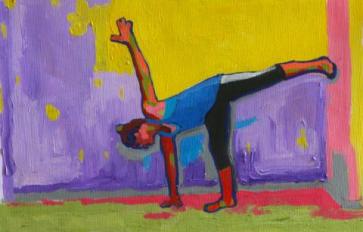
Alignment-based yoga is a broad term for any form of yoga that utilizes knowledge of anatomy to position the body precisely for optimal safety during asana practice. Cues help to align the posture with an awareness of the body’s natural tendencies. Certain schools of yoga have more of an attention to alignment than others.
Alignment-based practice may seem like it’s not overtly “spiritual”. Sometimes there is no incense, Ganesha statues, or even talk of God. However, it’s a practice that translates heavily into day-to-day life.
Alignment works because of its specificity. For example, in yoga, making a little adjustment in one area of the body can change the whole pose (and what you gain from it).
Alignment cues work similarly in life. When imbalanced, often this approach of tweaking any element that is off—such as relationships, negative patterns or diet and wellness – can make a colossal difference. Sometimes the change might appear small, but the alteration makes an arena of life feel more attainable. The tricky part is, when one finds balance there, the next day change is bound to happen again. This is the exciting, and at times utterly disorienting, process of life.
Alignment-based practice teaches the practitioner to tune in to what the body and life present them with at that moment, with the only permanent promise that what is subject to change, will. Even if one locked oneself in a room for an entire lifetime, away from society, family, or responsibility, the body and mental state will still change.
Alignment implores the practitioner to do two things: to be aware, and to be receptive. Alignment is a toolbox and awareness is the knowledge of when to use a hammer versus a wrench. Receptivity opens the toolbox.
If one truly believes yoga is a practice for all, one cannot ignore that alignment is synonymous with accessibility. Beginners gain awareness from understanding where the body is in space. This understanding, paired with intuition, guides one toward a deeper comprehension of where one needs to be (or not be). This makes practice available for life, rather than a brief encounter with asana acrobatics before injury.
Anusara Yoga is an alignment-based school of Hatha yoga, founded by John Friend. The first element is receptivity. This involves foundation and breath. In life, when someone is in distress the first thing an onlooker might suggest is to take a deep breath. Then they might return to basics, such as providing a glass of water. Like life, asana practice is an approach that builds from the ground up, such as ensuring the feet are hips-width apart. Even after the posture is established and one has gone through the other alignment elements (pelvic position and balanced action), it’s important to return to the first element. It is human nature to return to basic needs, always ensuring one’s foundation is solid.
I’ve taken beautiful classes where spirituality seems to be this mysterious and elusive beast, enveloped in the smell of Nag Champa and mantra. I love these classes for their ethereal element. However, I am drawn to alignment-based practice for its attainability and practicality. Alignment is both metaphorical and applicable to day-to-day life. It’s a practice that can reach all bodies. Alignment asks us to attune to what is happening now, always bringing us back to awakening.








